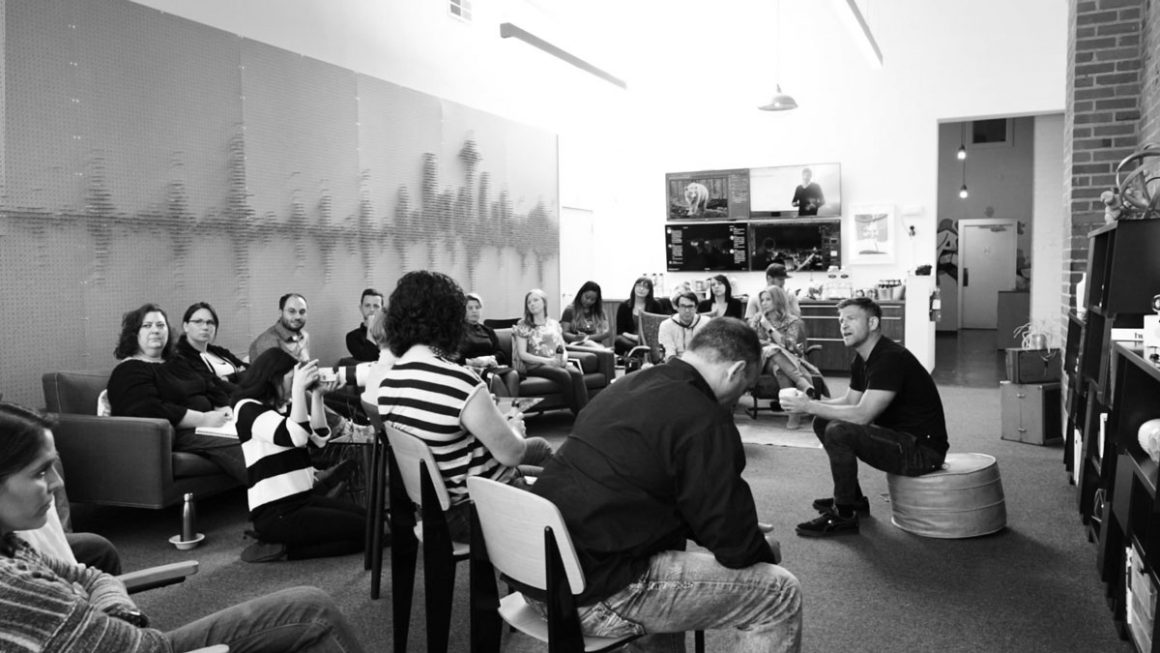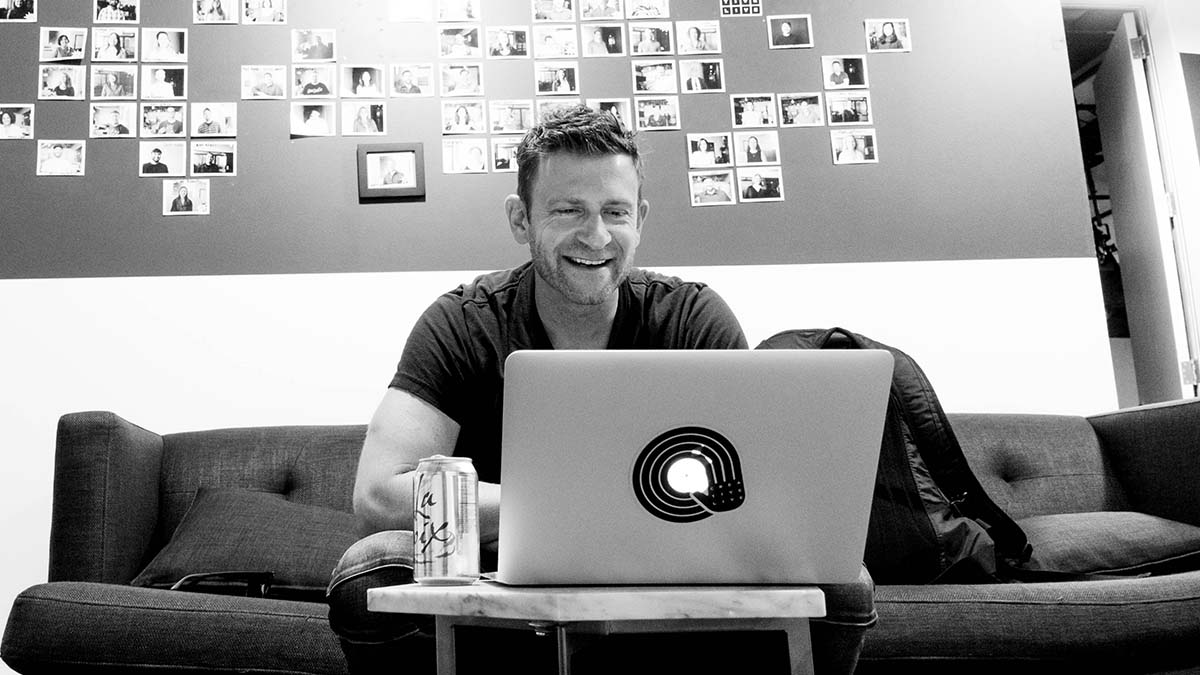 The idea of a solo creator who goes off to a cabin in the woods for a month and returns with a finished masterpiece?
The idea of a solo creator who goes off to a cabin in the woods for a month and returns with a finished masterpiece?
Purely a mirage.
We desperately need to connect with others: those with both similar and radically different influences and interests, those who love what we do, those who will give us honest feedback. We become more fully ourselves when we are in a community of other creators.
Working alone can be isolating and limiting. But when you work with others, you get access to new perspectives and skills. Moreover, building a sense of community and support is crucial for creative success. This is why creators need to find collaborators who are passionate, committed, and skilled.
By being selective about the creators with whom you collaborate, you can set the bar high on skill but even higher on creative alignment, work style, and the joyfulness of their company. It isn’t enough that the first software developer, sound engineer, or choreographer you meet is willing to join forces with you; find a collaborator whose skills and talents are as exciting to you as yours are to them. It takes effort to create a real creative match with one person, let alone several, but the benefits of a good match make up for it. Reciprocal collaboration is a powerful and energizing form of creative work. The right combination will feel less like being a dog walker and more like being in a wolf pack.
So how do you find the dream team of collaborators?
STEP 1: CLARIFY YOUR NEEDS
Before you start looking for team members, you need to be clear about your needs.
When I had the idea for Best Camera, the first photo sharing app on the App Store, I didn’t know how to make an app. One approach might have been to put the idea aside and go take a coding class, but this was one of those times when I knew I should delegate the work to an expert. I’d learned to value action over intellect. The time was right for the idea, and I knew exactly what I wanted to build—not the technical details, of course, but the user experience. Since Seattle was a tech hub, I just needed to find local collaborators whose strengths complemented my weaknesses and vice versa. (More on collaboration in chapter 10.) I started poking around, asking questions of my friends, and making connections within the local developer community. After meeting with a half-dozen groups or so, a friend referred me to a full-service development shop that seemed both capable and interested in my idea. It had built several apps already, a few with modest success. It seemed professional and organized. It was even located only a few blocks from my photo studio, and since the folks there were willing to trade development time for future revenue share, it seemed like an ideal match.
Ask yourself these questions:
- What skills and expertise do I need to complete this project successfully?
- What roles do I need to fill? And what type of work style and personality will mesh well with my own?
- Having a clear understanding of your needs will help you identify the right people for your team
Another angle of collaboration or even hiring people to help you with your project is to allow you to focus on your strengths, and areas you enjoy. If you haven’t listened to my recent conversation with Dan Martell, queue it up for your next episode to listen to. He goes deep into what he calles the “Buy Back Principle” which involves auditing your time to identify low-value, energy-sucking activities, transferring those activities to someone else through delegation, and then filling the newfound time with more productive or fulfilling activities. The idea is to reclaim your time and use it in a way that accelerates your business growth and personal fulfillment. By buying back your time, you can focus on the things that really matter, whether that’s doing more of the work that makes you money, investing in yourself, or simply enjoying more time with your family and loved ones.
STEP 2: EXPAND YOUR NETWORK

Now that you know what you’re looking for, it’s time to expand your network. Attend industry events, join online forums, and engage in conversations on social media. Be genuine and curious when meeting new people. The wider your network, the more likely you are to find the perfect fit for your team. And don’t forget to leverage your existing connections. Ask your friends and colleagues for recommendations—they might know someone who would be a great addition to your team.
And although geography isn’t as important as it once was thanks to the internet, there is still no good substitute for meeting other creators in person. Even medium-sized cities can support vibrant artistic communities. Whatever size yours is, help it grow. If there isn’t a community for you in your area yet, build one. Start by helping other people make stuff. Volunteer your skills, be willing to do what it takes, and get that karma flowing. You’ll learn quickly this way, and, eventually you’ll help build the foundation of a more vibrant creative ecosystem to support your own work.
STEP 3: LOOK FOR PASSION AND COMMITMENT

When you’re evaluating potential team members, it’s important to look beyond their skills and experience. Passion and commitment are just as crucial for the success of your project. Find people who share your vision and are willing to go the extra mile to make it a reality. During the interview or “getting to know them phase”, ask questions that reveal their passion for the work and their dedication to seeing it through.
You can gain a lot of insights from these types of questions:
- What motivates you to work in this field?
- Can you tell me about a particularly challenging project you worked on and how you overcame obstacles to see it through to completion?
- How do you stay up-to-date with the latest trends and advancements in your industry?
- Can you describe a time when you had to go above and beyond to meet a deadline or deliver a high-quality project?
- What do you do when you encounter setbacks or failures in your work?
STEP 4: PRIORITIZE DIVERSITY OF THOUGHT AND COMMUNICATION SKILLS
The best teams have diverse opinions and ideas. This brings a wider range of perspectives and experiences to the table, which can lead to more innovative and creative solutions. It will make your projects and team stronger as long as you have the other key ingredient: communication.
Communication is key in any collaboration, especially during times of stressful deadlines, unexpected mishaps, or conflict resolution. When building your team, prioritize people who are strong communicators, not only able to express their ideas clearly but also open to listening and understanding others. You want people who can give and receive feedback constructively, as this will help your team continuously improve and grow together. By fostering an environment of healthy communication, you set the stage for a positive culture where everyone feels valued and inspired.

During the interview or “getting to know them phase”, you can ask questions that reveal their communication skills, such as:
- How do you prefer to communicate with your teammates?
- Can you tell me about a time when you had to communicate a complex idea to someone who didn’t understand it at first?
- How do you handle disagreements or conflicts with your team members?
- Can you describe a time when you had to give constructive feedback to a teammate?
- What do you do when you don’t understand something someone is saying to you?
CONCLUSION
Identifying your needs and expanding your network are crucial steps in finding the right collaborators. But it’s also important to prioritize passion and commitment in potential team members, and to foster a culture of healthy communication and diversity of thought within your team. By doing so, you can build a team that not only has the skills and expertise necessary for success but also shares your vision and values, and is committed to achieving your goals.
So whether you’re a solo creator looking to collaborate with others or a team leader seeking to build a stronger and more productive team, finding the right collaborators is not always easy. It may take some effort and patience, but the rewards of a successful collaboration can be immense.
Enjoy!





















